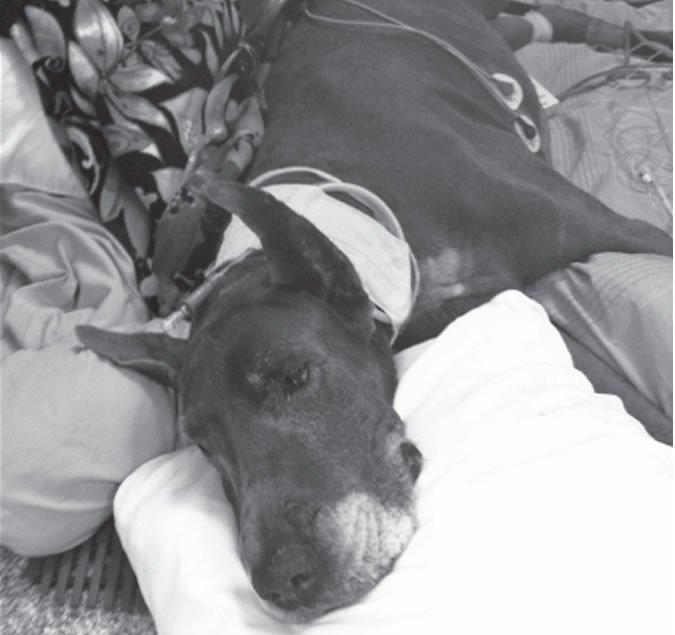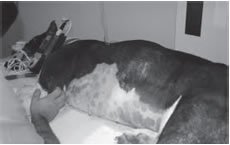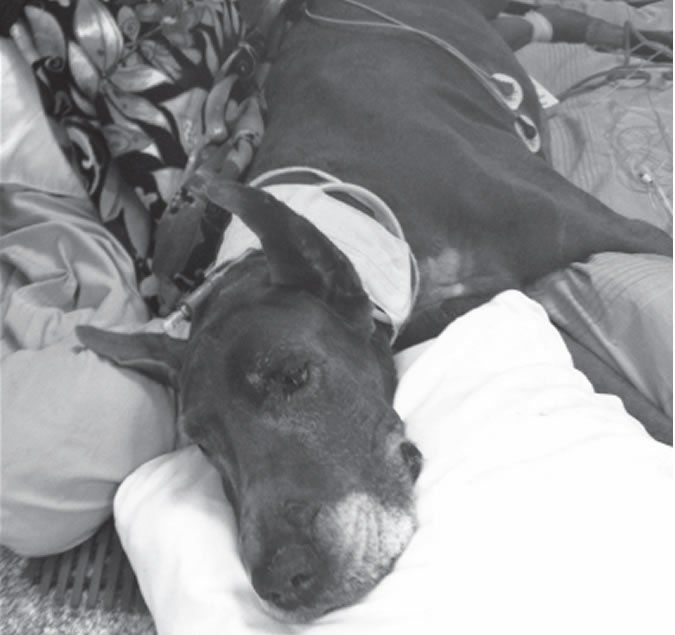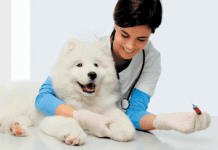

“A lot of dogs don’t look bloated from the outside,” says Tufts emergency and critical care veterinarian Claire Sharp, BVMS, DACVECC, referring to a life-threatening condition known in the vernacular as bloat, in which a dog’s stomach twists on its axis and fills with gas. She speaks of people who contact the animal hospital when their dog doesn’t seem right, saying, “‘I’m sure my dog doesn’t have bloat because his belly doesn’t look big.'”
But abdominal distention occurs in only about 50 percent of cases, she says, and people lose valuable time getting their dog to the emergency room when every second counts in whether a dog lives or dies. The reason owners can’t always see the stomach filling up like a balloon is that bloat, known medically as gastric dilatation and volvulus, or GDV (“dilatation” means “stretching out” while “volvulus” signifies “twisting”), tends to occur in large and giant-breed dogs with deep chests. In those dogs, explains Dr. Sharp, the stomach can occupy space on the back side of the rib cage, behind the diaphragm. In that position, the progressively enlarging stomach can’t be detected from the outside. It’s no doubt part of the reason that 10 to 20 percent of dogs who finally make it to the emergency room for treatment die. Too much time is lost. As the stomach becomes increasingly larger, it compresses a vein called the vena cava — the major blood vessel in the abdomen that returns blood to the heart. Thus, the heart doesn’t have enough blood to pump back out, and the dog goes into shock. It “progresses quite quickly” and will ultimately be fatal if not treated, Dr. Sharp says. “It’s very challenging for owners because the situation goes from fine to life-threatening in hours or even minutes.” While in shock, the dog’s heart rate goes as high as 160 to 180 beats per minute and sometimes much higher. In large dogs prone to GDV the heart rate should be closer to 60 to 70 beats per minute. Thus, the heart is pumping twice as hard to maintain the cardiac output of blood when the return of blood to the heart is inadequate. Blood pressure falls precipitously, too, and the dog will generally be in a significant amount of distress associated with abdominal pain.
“Dogs with bloat come to us in varying stages,” Dr. Sharp comments. Some owners of at-risk breeds — Great Danes, Weimaraners, Doberman pinschers, Saint Bernards, standard poodles, and others with large, deep chests — are super-observant and will bring them to us even if the dog is just acting funny because bloat is on their radar. But others don’t bring in their dog until she’s in a collapsed state. Some people — they go to bed, the dog is normal, wake up, and the dog is dead. We probably have at least one case a week where a dog died at home
with GDV.”
Because abdominal distention is not a sign that always occurs, owners should be aware of the other signs that may be indicative of bloat, namely retching and gagging. The dog will act as though she’s trying to vomit, but because the stomach is twisted, the conduit up the esophagus is cut off, so nothing can come up. “Often the dog will spit up a little bit of foamy fluid from the back of the throat or the esophagus,” Dr. Sharp says, “but it’s not true vomiting.” A dog’s being in obvious distress could be another sign.
Even if an owner recognizes these signs, however, saving the dog is not a given. “From the time the stomach twists, it is cutting off its own blood supply,” Dr. Sharp explains, “so the stomach wall starts to die. By the time you get a dog from the house into the operating room at the hospital, a significant part of the stomach may have already died. Or the stomach will burst prior to arriving at the hospital. I just saw a dog last Sunday whose owners said she was fine Saturday night. She was found dead in the morning.” Her stomach ruptured upon filling with too much gas after twisting, and food leaked into her abdomen.
Complicating all of this is that the surgery and post-operative care can run anywhere from $2,500 to $5,000 or more, depending on how stable the dog is following the operation. “So not only is it hard for owners to witness their dog going through all this before their eyes,” Dr. Sharp says, “but they also have to make a very quick decision about spending a sizable amount of money on what might be an uncertain outcome. They can’t sleep on it.”
Searching for a better heads-up
Because GDV forces owners to make a sudden, difficult decision about surgery, veterinary researchers have been looking for clues to better distinguish dogs with a poor prognosis from those with a better one. For instance, it has been known for some time that the higher the lactic acid level when a dog is brought in for GDV, the worse the outcome is likely to be. Scientists have now gone the extra step of measuring lactic acid a second time during treatment, after administering intravenous fluids to help correct the shock of a dog affected by bloat, to see if the second measurement could improve the prediction. It can. In a 2010 study, research at Tufts showed that the initial lactic acid reading is not nearly as telling as the second one. If lactic acid remains high after fluid administration with an IV drip, the dog is more likely to suffer complications during or after surgery and die. Specifically, high lactic acid concentrations signify a greater risk for dead stomach tissue in addition to heart arrhythmias and other problems.
Surgery always occurs quickly — within an hour of arriving at the hospital. “If only part of the stomach has already died by the time the dog is on the operating table,” notes Dr. Sharp, “you can flip the stomach right back into place, then remove that small part. Afterward, the stomach is stitched to the wall of the dog’s abdominal cavity so it can’t happen again — a procedure called a gastropexy. But in other cases, if most or all of the stomach has died, there are no options left at surgery. You can’t remove all of the stomach, and in those cases we are forced to euthanize during surgery.”
The spleen can be affected, too, in very bad cases, because it can twist along with the stomach. “The two organs are attached by a ligament,” Dr. Sharp explains. “Sometimes the spleen will have to be removed if the blood supply has been cut off to the point that the spleen starts to die,” only complicating the case and increasing the odds of death. However, assuming the dog survives, there are no negative long-term consequences of removing the spleen. On occasion, Dr. Sharp says, there can be multiple organ failure after GDV surgery, and the dog needs to be put down then. “Organs such as the kidneys and heart can shut down as a result of the dog being in shock for a period of time.”


As for lifestyle factors that might make a dog more likely to develop bloat in the first place, Dr. Sharp says that “bloat does tend to be more common in dogs fed a single large meal each day rather than two or three smaller meals a day.
“Nervous dogs have an increased risk for developing GDV, too,” she notes, “ones that are skittish, nervous, or anxious as compared to cool, calm, and collected. We’re not really sure why that is, but it does help to explain why bloat is more likely to happen when a dog is in a stressful situation, like at a kennel. We’ve had instances where a dog is in a kennel overnight recovering from knee surgery and develops GDV then,” when the animal is closed off in a cage in a strange place surrounded by strange dogs and people.
Physical activity may play a role as well. One study out of the University of Pennsylvania’s School of Veterinary Medicine and the American Kennel Club shows evidence that moderate physical activity after eating — such as leash walks — can potentially help prevent bloat from occurring. This finding suggests making a departure from the standard advice to keep a dog from running around or engaging in any other physical activity right after eating, the way mothers tell their children not to swim after they eat because it can cause abdominal cramps. It could be that activity after a meal helps improve bowel motility and encourages food to move on through, relieving pressure on a vulnerable dog’s stomach.
The problem is, all of these tantalizing associations and other pieces of evidence regarding the cause of GDV have not led to reductions in the frequency of the disease. For that reason, Dr. Sharp has decided to investigate the genetic root of the problem.
Unraveling secrets in the DNA
Along with knowing that large, deep-chested dogs are more prone to developing bloat than other dogs, scientists have some idea of why that’s the case. “It’s at least in part associated with the fact that their stomachs can become more mobile than normal,” Dr. Sharp says. “Normally, the stomach is held in position by ligaments connecting the stomach to the liver on one side and to the spleen on the other. But in dogs with GDV, those ligaments become stretched and enlarged, lax. We theorize that this action in deep-chested breeds is what triggers the problem.”
The question remains, however, why do some deep-chested dogs develop bloat and others not? For instance, it’s known that the lifetime risk in Great Danes is a little over 40 percent and in other large breeds, around 20 to 25 percent. What’s protecting some dogs and not others?
“Within the vulnerable breeds,” Dr. Sharp says, GDV runs in families. “The breed as a whole is at risk, but certain families have a much higher probability of having dogs who develop bloat than others. In fact, a given dog is much more likely to develop it if a first degree relative — dam, sire, littermate — has had it. Several studies have demonstrated that this is the case, and it’s reinforced anecdotally. When speaking with breeders and other owners, you learn that one or more dogs in every litter born to a specific mother and father will go on to have bloat. In some cases, three out of six dogs in a single litter will die of bloat in their lifetimes.” Clearly, there’s a genetic component.
“It’s not necessarily a true Mendelian pattern,” says Dr. Sharp, “either clearly dominant or recessive. The genetics are not simple. But there are definitely differences in the DNA of affected versus unaffected dogs. We think it’s a combination of genetic and environmental influences.” That is, in certain dogs, stress or diet or an anxious temperament may be more likely to trigger bloat than in other dogs.
For that reason, Dr. Sharp and colleagues at the Harvard- and MIT-affiliated Broad Institute have started research “to get a better idea of the genetics and the way genetics interplays with the environment.
“A big part of the study is in collecting DNA from dogs who have had and have not yet had GDV,” she says. Right now, she and her collaborating Tufts scientists are asking the public for blood samples of dogs who have already bloated, from which DNA can be examined.
“The ultimate goal,” says Dr. Sharp, “is to identify one or more genetic mutations associated with GDV. Then we hope to be able to develop a test and make it commercially available so breeders can test their dogs and engage in selective breeding, not using bitches and sires who have the telltale DNA. That will reduce the prevalence in the at-risk breeds over time.
“I don’t expect that we’re going to be able to solve this puzzle overnight,” Dr. Sharp says. “But nobody’s been able to make inroads into this yet at all. We’ll have answers we never had before. We should have initial results in about 12 months. All told, the project will take about 10 years. But there’ll definitely be some preliminary genetic analyses within the first year. Then we’ll keep working on it to slowly but surely get extra pieces of the puzzle to fit into the picture.
“Even a decade ago, before we had mapped out the entire dog genome, we couldn’t have tackled this,” she adds. “We’re definitely at the right time to start tackling big, complex disease questions such as those involved with bloat.”





